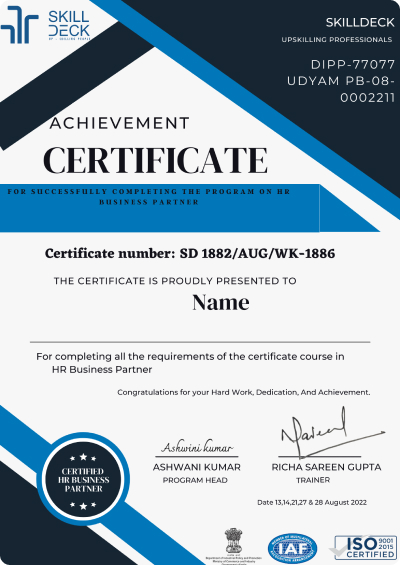- Tenure - 35+ Hours, 2 Month Program
- Starting from 26 July 2025 2025 | 7 - 9 PM
- Guaranteed Interview Calls
Reserve your seat for May batch, 7 Spots Left!
Strategic HR Business Partner Certification
Who Needs Our HR Business Partner Certification Program
For HR’s aiming to become strategic partners
Education
Graduates/Postgraduates in HR
Career Stage
Mid to senior-level professionals
Work Experience
2+ years in HR preferred
Aspirations
Achieving higher career growth
Build Your Resume
Build your profile with the latest trend and get easily placed in Top Corporates
Our HR Business Partner Certification Fee & Batch Details
Invest in your future with affordable degree fees and flexible batch options
Program Fee
8,850 INR
No installment plan available for this program
Limited time offer ₹12999
Hours
Minutes
Seconds
Batch Details
Application Closure Date: 7 Spot Left
Course End Date:26 July 2025 (Tentative)
Date for 1st Class: 26 July 2025
Seats On First Come- First Serve Basis.
Build your profile with the latest trend and get easily placed in Top Corporates
Our Course Certificates are trusted by these industry leaders










Build Your Resume
Build your profile with the latest trend and get easily placed in Top Corporates
Explore our HR Business Partner Certification Syllabus
What you will learn:
HRBP vs HR Generalist vs COE
- Business Partnering Essentials: Influence, Alignment, & Strategic Thinking
Overview of Performance Management
- Definition and objectives
- Importance in organizational success
Historical Development and Trends
- Evolution of performance management
- Current trends and future directions
Key Frameworks and Models
Objectives and Key Results (OKR)
- Understanding OKRs
- Setting and aligning OKRs
- Implementing and tracking OKRs
Key Result Areas (KRA)
- Defining KRAs
- Linking KRAs to organizational goals
- Measuring and evaluating KRAs
Key Performance Indicators (KPI)
- Identifying KPIs
- Developing effective KPIs
- Monitoring and analyzing KPI performance
Setting Effective Goals
SMART Goals
- Specific, Measurable, Achievable, Relevant, Time-bound
- Techniques for setting SMART goals
- Examples and case studies
Performance Prism
- Understanding the Performance Prism framework
- Five facets of the Performance Prism
- Applying the Performance Prism in performance management
Talent Management Grids and Tools
Talent Management Grids
- Introduction to talent management grids
- Assessing and categorizing talent
9-Box Grid
- Overview of the 9-box grid
- Using the 9-box grid for talent assessment
- Strategies for development and succession planning
Performance Appraisal Systems
Bell Curve Method
- Understanding the bell curve approach
- Advantages and disadvantages
- Implementing the bell curve in appraisals
Graphic Rating Scale
- Overview of graphic rating scales
- Designing effective rating scales
- Pros and cons of graphic rating systems
360-Degree Feedback
- Introduction to 360-degree feedback
- Implementing and managing 360-degree feedback processes
Behaviorally Anchored Rating Scales (BARS)
- Understanding BARS
- Developing BARS for performance evaluation
Management by Objectives (MBO)
- Key principles of MBO
- Aligning individual objectives with organizational goals
Advanced Performance Management Techniques
Balanced Scorecard
- Understanding the Balanced Scorecard framework
- Aligning performance with strategic objectives
- Implementing and managing Balanced Scorecards
Cascading Goals and Objectives
- Importance of cascading in performance management
- Techniques for cascading goals from top to bottom
- Ensuring alignment at all organizational levels
Integrating Performance Management with Business Strategy
- Linking Performance Management to Strategic Goals
- Ensuring alignment with company vision and mission
- Translating strategic goals into operational plans
- Creating a Strategic Performance Management Framework
- Developing a comprehensive framework
- Integrating various performance management tools and techniques
Role of Leadership in Performance Management
- Engaging leaders in the performance management process
- Leadership strategies for driving performance
Technology and Performance Management
Performance Management Systems and Software
- Overview of performance management software
- Selecting and implementing performance management tools
Using Data Analytics
- Leveraging data analytics for performance insights
- Predictive analytics in performance management
Succession Planning
Introduction to Succession Planning
- Definition and Importance
- Understanding what succession planning is
- Importance of succession planning for organizational stability and growth
Benefits of Succession Planning
- Reduced risk of leadership gaps
- Enhanced talent development
- Increased employee engagement and retention
Succession Planning Frameworks
- Key Components of a Succession Plan
- Identifying critical roles and key positions
- Assessing potential successors
- Developing succession strategies
Designing a Competency Framework: Step-by-Step
Role-Based vs Level-Based Competencies
Skill Matrix Design and Practical Application
Integration with PMS, L&D and Hiring
Competence Assessment with 90-720 Degree
Competence Assessment with ADC Exercises
Demand Planning and Forecasting
Creating Role-Based JDs
Advanced Sourcing (LinkedIn, GitHub, Chrome Tools, X-ray Search)
Passive Candidate Engagement
Recruitment Funnel Metrics & Hiring SLAs
Selection Strategy, TA Dashboarding & TA Cost Control
Strategic Onboarding Integration
Introduction to HR Budgeting
- Definition and Importance
- Understanding what HR budgeting is and why it is crucial
- The role of HR budgeting in organizational success
Types of HR Budgets
- Operational budgets
- Capital budgets
- Project-based budgets
Strategic Alignment and Planning
- Aligning HR Budget with Organizational Goals
- Ensuring the HR budget supports business objectives
- Integrating HR strategy with financial planning
Forecasting and Planning
- Techniques for accurate forecasting
- Long-term and short-term planning considerations
Components of an HR Budget
Employee Compensation and Benefits
- Salaries, wages, bonuses, and incentives
- Health benefits, retirement plans, and other perks
Recruitment and Talent Acquisition
- Costs associated with hiring and onboarding
- Budgeting for recruitment marketing and employer branding
Training and Development
- Allocating funds for employee training programs
- Investment in leadership development and continuous learning
Employee Relations and Engagement
- Budgeting for engagement initiatives and events
- Allocating resources for employee recognition programs
HR Technology and Systems
- Investing in HR software and tools
- Costs of implementation, maintenance, and upgrades
Compliance and Legal Costs
- Budgeting for compliance-related activities
- Legal fees and regulatory costs
Budget Development Process
Steps in Budget Preparation
- Gathering and analyzing data
- Involving key stakeholders in the budgeting process
Setting Budget Priorities
- Identifying critical areas and prioritizing spending
- Balancing needs versus available resources
Creating Budget Templates
- Designing effective budget templates for different HR functions
- Standardizing budget formats and categories
Budget Management and Monitoring
Implementing the Budget
- Rolling out the budget to HR teams
- Communicating budget expectations and guidelines
Tracking and Monitoring Expenses
- Techniques for real-time budget tracking
- Tools for monitoring budget performance
Adjusting the Budget
- Making necessary adjustments in response to changing circumstances
- Ensuring flexibility and adaptability
Budget Reporting and Analysis
Financial Reporting
- Preparing regular budget reports for stakeholders
- Key metrics and KPIs for budget reporting
Variance Analysis
- Identifying and analyzing budget variances
- Taking corrective actions based on variance analysis
Performance Evaluation
- Evaluating the effectiveness of HR spending
- Linking budget performance to HR outcomes
Introduction to HR Policy Making
- Definition and Importance
- Understanding what HR policies are and their significance
- The role of HR policies in organizational success
Types of HR Policies
- Operational policies
- Strategic policies
- Compliance policies
Fundamentals of Policy Making
Principles of Effective Policy Making
- Clarity, consistency, and fairness
- Alignment with organizational values and culture
Policy Development Process
- Steps involved in creating HR policies
- Gathering input from stakeholders
Research and Benchmarking
- Conducting research to inform policy development
- Benchmarking against industry standards and best practices
Key Components of HR Policies
Employee Conduct and Discipline
- Code of conduct
- Disciplinary procedures and actions
Workplace Health and Safety
- Safety protocols and procedures
- Health and wellness initiatives
Compensation and Benefits
- Salary structures and pay scales
- Employee benefits and perks
Leave and Attendance
- Leave policies (annual leave, sick leave, maternity/paternity leave)
- Attendance and punctuality expectations
Equal Employment Opportunity (EEO)
- Anti-discrimination and harassment policies
- Promoting diversity and inclusion
Data Protection and Privacy
- Employee data protection policies
- Confidentiality agreements
Policy Implementation and Communication
Developing Implementation Plans
- Steps for rolling out new policies
- Training and support for employees and managers
Communication Strategies
- Effective communication of policies to employees
- Ensuring understanding and compliance
Documentation and Accessibility
- Maintaining clear and accessible policy documents
- Using technology for policy management
Compliance and Legal Considerations
Understanding Employment Laws
- Key employment laws and regulations impacting HR policies
- Ensuring legal compliance in policy development
Auditing and Monitoring
- Regular audits to ensure compliance
- Monitoring and updating policies as needed
Policy Review and Evaluation
Reviewing Policies
- Regular policy reviews to ensure relevance and effectiveness
- Gathering feedback from employees and managers
Evaluating Policy Impact
- Measuring the impact of policies on organizational performance
- Making necessary adjustments based on evaluation
Best Practices in HR Policy Making
Building a Positive Workplace Culture
- Promoting policies that enhance employee engagement and satisfaction
- Encouraging open communication and feedback
Continuous Improvement
- Staying updated with industry trends and best practices
- Continuously improving HR policies to meet evolving needs
Strategic Onboarding Framework
- Buddy Model
- 30-60-90 Days Plan
Employee Experience Design
- From Preboarding Onward
Drivers of Employee Engagement
- Engagement Mapping
Survey Design, Action Planning & Measurement
Building an EVP-Aligned Culture
Employee Engagement Strategies
HRBP’s Role in Retention & Belonging
L&D as a Strategic Driver of Capability Building
TNI Techniques
- PMS
- Skill Matrix
- Manager Input
Designing Learning Journeys
- Technical Tracks
- Behavioral Tracks
- Leadership Tracks
ADDIE Framework & Honey and Mumford Styles
Kirkpatrick Evaluation Levels & L&D ROI
LMS Tools & Digital Learning Ecosystem
Internal vs External Training Strategy
Part A: Introduction to HR Analytics
- What is HR Analytics?
- Role of HRBP in Data-Driven HR
- Descriptive, Diagnostic, Predictive, and Prescriptive Analytics
- Key Metrics Across HR Functions (TA, L&D, PMS, Attrition, Engagement)
Part B: Excel-Based Analytics
- Excel Formulas: VLOOKUP, IF, COUNTIFS, SUMIFS
- Pivot Tables & Dynamic Charts
- Attrition Analysis, Hiring Funnel, TNA Dashboards
- Trend Forecasting using Excel
- Creating Monthly & Quarterly Review Dashboards
Part C: Power BI for HR
- Power BI Basics: Importing HR Data
- Building Interactive Dashboards: Attrition, Recruitment, Engagement
- Visualizations: Heat Maps, Drill-Down Reports, Slicers
- Power BI for Manpower Forecasting & Real-Time Reporting
- Sharing Dashboards with Leadership
Module 1: Introduction to HR Audits
- Definition and Purpose of HR Audits
- Types of HR Audits: Compliance, Best Practices, Strategic, Function-Specific
- Importance of HR Audits
- Overview of ISO Standards for Audits
Module 2: Planning the HR Audit
- Establishing Objectives and Scope
- Identifying Key Areas for Audit
- Developing an Audit Plan
- Selecting Audit Tools and Techniques
Module 3: Understanding ISO Standards
- ISO 9001, ISO 30414, ISO 27001, ISO 34001, ISO 45001, ISO 14001, ISO 10015
- Application of ISO Standards in HR Audits
Module 4: Conducting the HR Audit
- Data Collection Methods
- Interviews and Surveys
- Document Review and Analysis
- Observations and Site Visits
Module 5: Analyzing HR Processes
- Recruitment, Onboarding, Training & Development
- Performance Management, Compensation & Benefits
- Employee Engagement, Compliance & Legal
- Information Security, Health & Safety, Environmental Management
Module 6: Evaluating HR Metrics
- Key HR Metrics and KPIs
- Benchmarking Against Industry Standards
- SWOT Analysis
- Data-Driven Decision Making
Module 7: Reporting and Documentation
- Preparing the Audit Report
- Findings and Recommendations
- Action Plans and Follow-Up
- Presenting Results to Stakeholders
Module 8: Continuous Improvement
- Implementing Audit Recommendations
- Monitoring and Reviewing Changes
- Continuous Improvement Strategies
- Maintaining Compliance with ISO Standards
Module 9: Case Studies and Practical Applications
- Real-World Examples of HR Audits
- Group Discussions and Exercises
- Role-Playing Audit Scenarios
- Best Practices and Lessons Learned
Module 10: Labor Law Audit
- Understanding Labor Laws
- Assessing Employment Contracts
- Workplace Policies and Procedures
- Employee Rights and Obligations
- Handling Disputes and Grievances
- Documentation and Record-Keeping
Module 11: Preparing for Certification
- Understanding Certification Requirements
- Preparing Documentation and Evidence
- Conducting Internal Audits
- Working with External Auditors
Module 1: Introduction to Job Analysis
- Definition and Importance
- Methods of Job Analysis: Observations, interviews, questionnaires, and work logs
- Job Descriptions and Specifications
Module 2: Conducting Job Analysis
- Data Collection Techniques
- Analyzing Job Data
Module 3: Job Benchmarking
- Introduction to Job Benchmarking
- Benchmarking Process
- Using Benchmarking Data
Module 4: Job Evaluation Methods
- Overview of Job Evaluation
- Job Evaluation Techniques: Ranking, Classification, Factor Comparison
Module 5: Point-Factor Job Evaluation System
- Introduction to Point-Factor System
- Designing a Point-Factor System
- Implementing the Point-Factor System
Module 6: Practical Application of Job Evaluation
- Case Studies
- Job Evaluation Exercises
Module 7: Aligning Job Evaluation with Compensation
- Compensation Structures
- Using Job Evaluation for Compensation Decisions
Module 1: HR Planning
- Understanding workforce requirements, planning for employee transfers, and managing increments
- Salary Components: Differentiating between fixed and variable components, bonuses, fees, commissions, and overtime payments
- CTC Structure: Understanding Cost to Company (CTC), structuring CTC, taxable and non-taxable components
Module 2: Labour Law Statutory Compliances & Computation
- PF and ESI: Contributions, calculation, deposit timelines, and compliance
- Professional Tax and Labor Welfare Fund: State-wise slabs, applicability, payment procedures, and registration
Module 3: Tax Calculation, Tax Saving Investments, Deductions, and Exemptions
- TDS: Income tax slabs, computation of TDS, and implications
- Exemptions and Deductions: Chapter VI-A, Sections 80C to 80U
- Breakdown of HRA, LTA, leave encashment, and gratuity exemptions
Module 4: Allowances and Perquisites
- Section 10 Allowances: HRA, special allowances under 10(13A) and 10(14)
- Perquisites: Valuation and tax implications of various perquisites
Module 5: Fixed and Flexible Salary Structures
- Salary Structures: Fixed vs flexible components, benefits and limitations
- Designing a flexible salary package for organizational and employee needs
Module 6: Payroll Processing and Reports
- Payroll Processing: From data collection to verification
- Claims and Reimbursement Management: Medical/travel reimbursements, expense claims
- Attendance Management and Resignation: Time, leave, and full & final settlement
- Reporting and Documentation: Salary registers, salary slips, MIS reports, bank transfers
Interested in HRBP Course?
Course Overview
Why SkillDeck?
- Globally recognised Platform
- DIPP, ISO, MSME from Govt of India
- Globally accepted certification
- Lifetime Recording accessibility
- Join 40,000+ members worldwide
- Career Guidance


Trained
5,00,000

Live Classes/Month
500+
Google Reviews
1000+

Corporate Partners
50+

College Partner
90+

career benefits
91%
Pricing
₹8,850 ₹12999
- Certified & Experienced Instructors
- Flexible Schedule
- Masterclasses By Skill Deck®️
- Placement Assistance
- Access to the Recorded Sessions
- Live-Online Training
- Tailor Made Training
- 10 in 1 Program
- Globally recognised Platform

Meet Your Trainer
Richa Sareen
About the Trainer – Richa Sareen
Richa Sareen brings over 18 years of hands-on experience in Human Resources, having held strategic roles including HR Director and Head of Talent Acquisition across leading organizations. She is the Founder of SkillDeck, a premium HR consulting and training platform, where she has successfully trained and mentored over 5,000 HR professionals across India and abroad.
Richa’s programs are known for their practicality, industry relevance, and case study-based approach, covering everything from labor laws and HR audits to payroll, PMS, and strategic HR partnering. Her training is deeply rooted in real-time experience, making it easy for professionals to implement the learnings from day one.
🏆 Recognized Excellence:
SIWAA Award Winner – For outstanding contribution in HR training
IHRC Award – For Innovation in Human Resource Consulting
IEA Award – For Excellence in Employee Engagement & HR Solutions
🎥 She is also a well-known HR content creator on YouTube, simplifying complex HR topics like manpower planning, compliance, and Boolean search sourcing using real tools, templates, and examples. rephrase in small
Our Courses Certificates are trusted by these industry leaders










Strategic Human Resource Partnering Course Training Certification Process
Counseling & Registration
Consult one of the counselors to enroll in the right batch. Register yourself for Strategic Human Resource Partnering Course
Join the Strategic HR Partnering Course
Attend live sessions and earn your certificate. Missed one? Watch the recordings anytime.
Submission of Projects Assigned
Submit the Hand-on Projects assigned during the training to the Trainers for Assessment and Certification
Earn Certification
Post Completion of the training, get Course Completion Certification of Strategic Human Resource Partnering Course from The SkillDeck®
Hear it from our Alumni
FAQs
Curriculum is specifically engineered to meet the expectations of leading tech companies.
As the world of work evolves, so does the need for strategic human business partners. This course will def will make you subject matter expert in human resource business partnering
- HR & Administration Personnel Office & Factory
- Managers/Supervisors
- Anyone interested in strategic Hr planning with little background of human resources
The pedagogy is highly interactive, comprising case studies, interactive sessions, quizzes, assessments, class participation, presentations, project work, and class exercises imparted by SkillDeck faculty to help participants gain the knowledge, understanding, and hands-on skills to immediately apply their learning in the workplace.
Click here for certificate sample.
This is an online instructor led course where trainer will teach you over zoom
Yes skillDeck is a globally accredited firm with international accreditations and is also ISO, DIPP ,MSME registered under Indian laws so your certificate is globally accepted

x
x
Welcome to SkillDeck
x
Download Brochure
x
